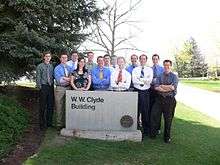BYU Mars Rover

The BYU Mars Rover is a student designed, built and run project overseen and funded primarily by the Mechanical Engineering, Electrical Engineering and Physics departments at Brigham Young University. The rover competes annually in the University Rover Challenge (URC) near Hanksville, Utah at the Mars Desert Research Station, and is currently being evaluated for research use.
History
The BYU Mars Rover project is currently in its fifth year, after being started by BYU Physics Professor Dr. David Allred when he announced the upcoming URC in his second semester physics class.[1]
2007
After deciding to compete in the first URC, and being funded primarily by the BYU Physics Department and Dr. Allred, the team began construction on a simple rover design, using 3/4" square aluminum tubing for the chassis, and a four wheel drive, skid steer type drivetrain using brushless motors. The rover also had stereo video transmitted over 900 MHz analog video links.[2][3][4]
The first year the BYU rover took second place at the competition, coming in behind the University of Nevada, Reno rover, and ahead of Penn State and UCLA.[5][6]
2008
For the 2008 season, the BYU rover was completely redesigned and rebuilt from scratch, with a completely new drivetrain, a suspension, and a custom designed and built robotic arm. Unfortunately, the redesign left no time for testing, and the rover did not complete its first drive until the team was actually at the event.
After solving computer issues the first day of events, the BYU rover competed in the Soil Science task on the morning of the second day, but broke their drivetrain within minutes of leaving the start gate. This failure led the BYU team to finish in fifth place.[7][8]
2009

After the past year's mechanical failures and software issues, the rover was modified, as the team felt that the basic design of the rover was sound, it just needed revision. As such, the chassis was kept mostly the same, but a completely new suspension was designed and built, and a new drivetrain was selected, as well as switched the operating system on the rover from Windows XP to Debian GNU/Linux.
Another goal of the team was to test the rover a month before the URC, a task that was accomplished with the drivetrain and other basic controls, but not with video or the arm.
At the event, the rover was able to actually compete in all of the tasks for the first time, with no major failures. The primary limitations were radio range, and limited testing with the robotic arm. As such, the rover did well at competition, finishing in second place.[9][10]
Technical overview
Mechanical systems
As of 2009, the BYU Mars Rover is a four wheel drive, skid steer type vehicle, approximately 36" long, 40" wide, and 20" tall (excluding antenna and camera mast). Each wheel is approximately 12" in diameter, and is powered by a brushless electric motor and planetary gearbox. The suspension is a fully independent A-arm design, with CNC milled A-arms, and is well integrated into the rover chassis in order to reduce weight and complexity.
The rover arm is a student designed and built 5 degree of freedom robotic arm using high resolution optical encoders and high torque planetary gear motors as well as timing belt gearing.
Control systems
The rover is controlled using a variety of off the shelf computing platforms. The primary computer is a 1 GHz Intel single-board computer (SBC) running Ubuntu Linux and connected to the communications radios over Ethernet. In addition, the arm and servo control is handled by an ARM SBC running at 500 MHz and a Lynxmotion 32 output servo controller.
The rover uses a 900 MHz radio with a theoretical throughput of 54 Mbit/s and an output power of up to 700 mW. Both the base station and rover side radios are connected to omnidirectional antennas.
Awards
- Second Place, 2007 University Rover Challenge - Rover 1
- Fifth Place, 2008 University Rover Challenge - Rover 2
- Second Place, 2009 University Rover Challenge - Rover 2.1
- Fourth Place, 2010 University Rover Challenge - Rover 2.2
- Fourth Place, 2011 University Rover Challenge - Rover 2.2.1
- Second Place, 2012 University Rover Challenge - Rover 3.0
- Third Place, 2013 University Rover Challenge-
- Fourth Place & Judges Award, 2014 University Rover Challenge-
- Second Place, 2015 University Rover Challenge -
References
- ↑ BYU land rover explores planet Earth - in 3-D, Salt Lake Tribune, June 3, 2007, 6049690
- ↑ http://www.deseretnews.com/article/1,5143,660226414,00.html
- ↑ http://www.heraldextra.com/news/local/article_eec81237-e65a-5014-8e73-fb4b9f416f90.html
- ↑ http://nn.byu.edu/story.cfm/64493
- ↑ http://www.marssociety.org/portal/c/urc/2007-urc-archive/announcements/UNR%20Wins%20Inaugural%20University%20Rover%20Challenge.pdf/?searchterm=2007%20URC
- ↑ Race to Mars Miniseries, Daily Planet, Discovery Channel Canada
- ↑ http://www.marssociety.org/portal/Members/schnarff/URC2008Results/?searchterm=2008%20URC
- ↑ http://www.scientificamerican.com/article.cfm?id=university-rover-challenge
- ↑ http://www.informationweek.com/news/showArticle.jhtml?articleID=217701095
- ↑ http://www.marssociety.org/portal/c/urc/2009FinalResults/
External links
- Official Website
- University Rover Challenge Website
- BYUTV coverage of 2007 BYU Mars Rover
- Discovery Channel coverage of 2007 URC